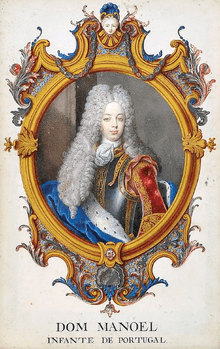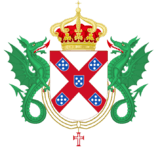Infante Manuel, Count of Ourém
Infante Manuel, Count of Ourém, KGF (Portuguese pronunciation: [mɐnuˈɛɫ]; Manuel José Francisco António Caetano Estêvão Bartolomeu; (Lisbon, August 3, 1697 - Quinta de Belas, August 3, 1766) was a Portuguese infante (prince), seventh child of Peter II, King of Portugal, and his wife Maria Sophia of Neuburg. He was the brother of King John V of Portugal. He was a candidate for the Polish throne.
| Infante Manuel | |||||
|---|---|---|---|---|---|
| Count of Ourém | |||||
 | |||||
| Born | August 3, 1697 Lisbon, Kingdom of Portugal | ||||
| Died | August 3, 1766 Quinta de Belas, Kingdom of Portugal | ||||
| Burial | Royal Pantheon of the House of Braganza | ||||
| |||||
| House | House of Braganza | ||||
| Father | Pedro II of Portugal | ||||
| Mother | Maria Sofia of the Palatinate | ||||
| Religion | Roman Catholicism | ||||
Life
He was born on August 3, 1697 in Lisbon and died unmarried and without legitimate issue at the Quinta de Belas in the same city on the same day in 1766. He is buried at the Royal Pantheon of the Braganza Dynasty in Lisbon.
Manuel led an adventurous life. At the age of 18, he embarked in secret on an English ship with destination the Netherlands. Ordered by his brother King John V of Portugal to return home, he disobeyed and went to Paris and then to Germany.
On August 1, 1716, he offered his services to Prince Eugene of Savoy, to fight the Turks in Hungary. There he fought 4 days later in the Battle of Petrovaradin where he was slightly wounded but covered with glory. He also participated in the pursuit of the fleeing Turks and the siege and capture of Timișoara.
In 1717, now officially in the Austrian army, he again fought under Prince Eugen and participated in the conquest of Belgrade.
After the Treaty of Passarowitz, he obtained the title of Maréchal de camp. After the war he traveled from court to court, living a life filled with pleasure, inspiring several contemporary writers. In 1721 he received the Order of the Golden Fleece.
In 1728 he became one of the candidates for the hand of the wealthy Maria Zofia Sieniawska supported by the Habsburgs in attempt to gain a strong position in Poland before the Royal Election.[1] Well known at the Austrian and Russian court, he was even proposed as the next King of Poland for a short time in 1733, in the onset of the War of Polish Succession.[2]
The next year he returned to Portugal, where he spent the last years of his life in the Quinta de Belas, leading a socially active life, surrounded by writers and artists. He died on his 69th birthday more than three decades later.
Ancestry
| Ancestors of Infante Manuel, Count of Ourém | |||||||||||||||||||||||||||||||||||||||||||||||||||||||||||||||||||||||||||||||||||||||||||||||||||||||||||||||||||||||||||||||||||||||||||||||||||||||||||||||||||||||||||||||||||||||||||||||||||||||||||||||||||||||||||||||||||||||||||||||||||||||||||||||||||||||||||||||||||||||||
|---|---|---|---|---|---|---|---|---|---|---|---|---|---|---|---|---|---|---|---|---|---|---|---|---|---|---|---|---|---|---|---|---|---|---|---|---|---|---|---|---|---|---|---|---|---|---|---|---|---|---|---|---|---|---|---|---|---|---|---|---|---|---|---|---|---|---|---|---|---|---|---|---|---|---|---|---|---|---|---|---|---|---|---|---|---|---|---|---|---|---|---|---|---|---|---|---|---|---|---|---|---|---|---|---|---|---|---|---|---|---|---|---|---|---|---|---|---|---|---|---|---|---|---|---|---|---|---|---|---|---|---|---|---|---|---|---|---|---|---|---|---|---|---|---|---|---|---|---|---|---|---|---|---|---|---|---|---|---|---|---|---|---|---|---|---|---|---|---|---|---|---|---|---|---|---|---|---|---|---|---|---|---|---|---|---|---|---|---|---|---|---|---|---|---|---|---|---|---|---|---|---|---|---|---|---|---|---|---|---|---|---|---|---|---|---|---|---|---|---|---|---|---|---|---|---|---|---|---|---|---|---|---|---|---|---|---|---|---|---|---|---|---|---|---|---|---|---|---|---|---|---|---|---|---|---|---|---|---|---|---|---|---|---|---|---|---|---|---|---|---|---|---|---|---|---|---|---|---|---|---|---|
| |||||||||||||||||||||||||||||||||||||||||||||||||||||||||||||||||||||||||||||||||||||||||||||||||||||||||||||||||||||||||||||||||||||||||||||||||||||||||||||||||||||||||||||||||||||||||||||||||||||||||||||||||||||||||||||||||||||||||||||||||||||||||||||||||||||||||||||||||||||||||
See also
References
- "Czartoryska z Sieniawskich Maria Zofia". Polski Słownik Biograficzny (in Polish). Retrieved 2010-09-01.
- Paweł Sieradzki (2006). Obecność rodziny książąt Czartoryskich na ziemi jarosławskiej (The presence of the Czartoryski dukes in the land of Jarosław). Teka Komisji Historycznej OL PAN (99–123). p. 106.
